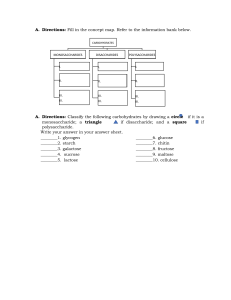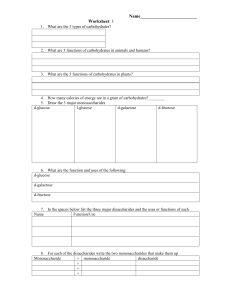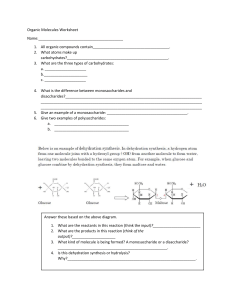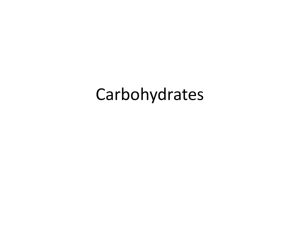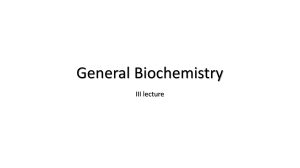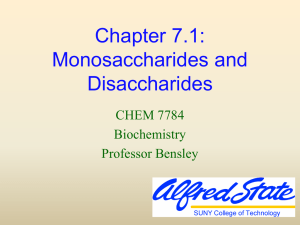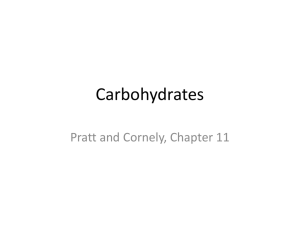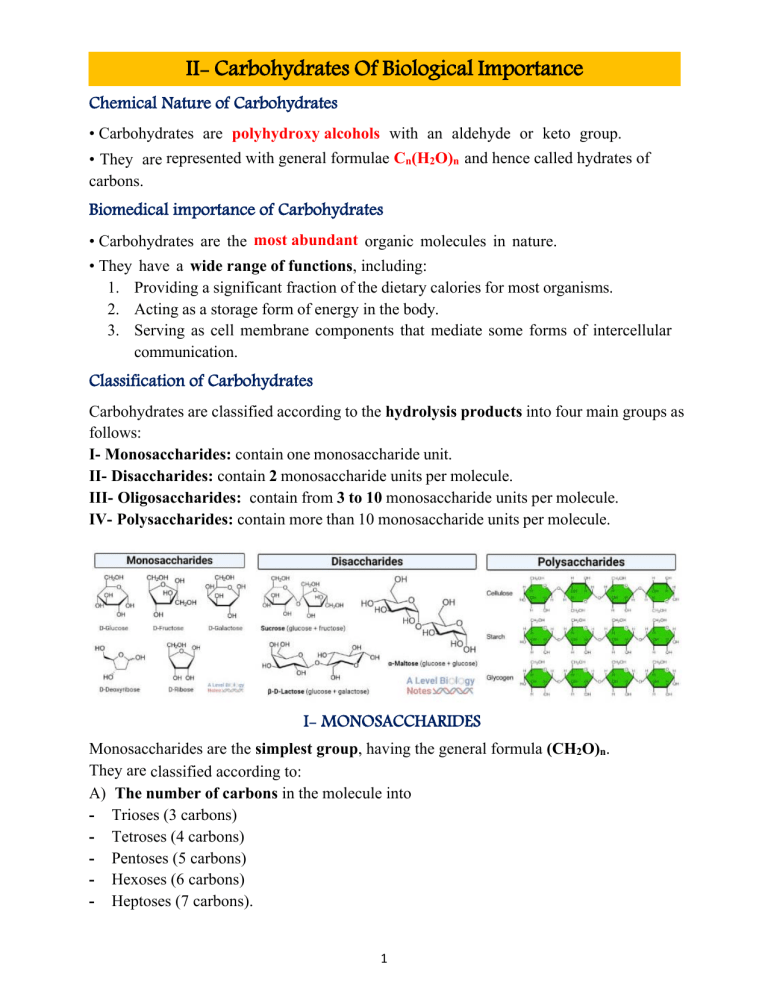
II- Carbohydrates Of Biological Importance Chemical Nature of Carbohydrates • Carbohydrates are polyhydroxy alcohols with an aldehyde or keto group. • They are represented with general formulae Cn(H2O)n and hence called hydrates of carbons. Biomedical importance of Carbohydrates • Carbohydrates are the most abundant organic molecules in nature. • They have a wide range of functions, including: 1. Providing a significant fraction of the dietary calories for most organisms. 2. Acting as a storage form of energy in the body. 3. Serving as cell membrane components that mediate some forms of intercellular communication. Classification of Carbohydrates Carbohydrates are classified according to the hydrolysis products into four main groups as follows: I- Monosaccharides: contain one monosaccharide unit. II- Disaccharides: contain 2 monosaccharide units per molecule. III- Oligosaccharides: contain from 3 to 10 monosaccharide units per molecule. IV- Polysaccharides: contain more than 10 monosaccharide units per molecule. I- MONOSACCHARIDES Monosaccharides are the simplest group, having the general formula (CH2O)n. They are classified according to: A) The number of carbons in the molecule into - Trioses (3 carbons) - Tetroses (4 carbons) - Pentoses (5 carbons) - Hexoses (6 carbons) - Heptoses (7 carbons). 1 B) The presence of aldehyde or ketone group into aldoses and ketoses. I– Aldoses: - The mother compound of all aldoses is the aldotriose glyceraldehyde. - Other aldoses can be formed theoretically; by insertion of secondary alcohol groups (HC-OH) below the aldehydic group of glyceraldehyde. - All sugars derived from D-glyceraldehyde are called D-sugars, as indicated by having the hydroxyl group of the penultimate carbon atom (the carbon atom before the last) to the right, while those derived from L-glyceraldehyde are called L- sugars (contain hydroxyl group on the left side of the penultimate carbon atom). - Most of the naturally occurring monosaccharides are of the D type. Aldoses are further classified according to the number of carbon atoms present into: 1. Aldotrioses (C3) e.g. D- glyceraldehyde. 2. Aldotetroses (C4) e.g. D-erythrose. 3. Aldopentoses (C5) e.g. D-ribose and D-xylose. 4. Aldohexoses (C6) e.g. D-glucose, D-mannose, D-galactose. 2 II- Ketoses: - All ketoses have two terminal primary alcohol groups (CH2OH) and have one ketone group (C=O). - The simplest ketose is dihydroxyacetone (C3). - Other ketoses are formed, theoretically, by the insertion of secondary alcohol groups (H-C-OH) below the ketonic group. - Ketoses are further classified according to the number of carbon atoms present into: 1. Ketotrioses (C3): dihydroxyacetone. 2. Ketotetroses (C4) e.g. D-erythrulose. 3. Ketopentoses (C5) e.g. D-ribulose. 4. Ketohexoses (C6) e.g. D-fructose. 5. D-Sedoheptulose is the only one in human that contains seven carbons; it is formed in the body from glucose. 3 Important Monosaccharides 1. Trioses: • Glyceraldehyde 3-phosphate and dihydroxyacetone phosphate are intermediates during glucose oxidation in living cells. 2. Tetroses: • Erythrose 4-phosphate is formed during glucose oxidation in living cells. 3. Pentoses: • D-ribose: component of many nucleosides and nucleotides and ribonucleic acids (RNA). • 2-deoxyribose is a component of deoxyribonucleic acid (DNA). 4. Hexoses: • D-glucose is the main sugar present in blood, and it enters in the formation of many disaccharides and polysaccharides. • D-fructose It is a component of sucrose and inulin. • D-galactose is a component of lactose which is present in milk. - It is also found in glycosaminoglycans (GAGS), glycolipids and glycoproteins. 4 Forms of Isomerism of Monosaccharides: - Isomers are compounds which have the same molecular formula (the same number and types of atoms) but have different structural formula (connection of these atoms) or steric formulae. - Stereoisomers are isomeric molecules that have the same molecular formula and sequence of bonded atoms (constitution), but differ in the three-dimensional orientations of their atoms in space. 1. Optical isomers (D and L-sugars): - These are compounds which contain at least one asymmetric carbon atom (attached to four different atoms or groups) and they are optically active. -Asymmetric carbon atoms are those attached to four different atoms or groups. - All monosaccharides contain one or more asymmetric carbon atoms except DHA. - Most of the monosaccharides occurring in mammals are D sugars, and the enzymes responsible for their metabolism are specific for this configuration. - Enantiomers: They are the D- and L- forms of the same compounds (mirror images) e.g., D and L-glucose. 5 2. Anomers (cyclic structure of monosaccharides): -In solution, the functional aldehyde group of glucose combines with hydroxyl group of 5th carbon atom. - As a result, a 6 membered heterocyclic pyranose ring structure containing 5 carbons and one oxygen is formed. - Similarly, a 5 membered furanose ring structure is formed from fructose when its keto group combines with hydroxyl group on 5th carbon atom. - In either case, a new asymmetric carbon is created by the reaction and known as the anomeric carbon and the two possible configurations as anomers. - Cyclization creates a carbon with two possible orientations of the hydroxyl group around it (α-form and β-form). - In case of D-sugars: • The α- form has the OH group to the right of the anomeric carbon • The β- form has the OH group to the left of the anomeric carbon. 6 - In case of D-Fructose: • Furanose is formed due to the cyclization between C5 and C2, and it is present in the disaccharide (sucrose) and polysaccharide (inulin). - In case of D- Ribose: cyclization occurs between C4 and C1. 3. Epimers: - They are compounds which have more than one asymmetric carbon and differ only in the configuration around one carbon. - Examples: - D-Glucose and D-mannose are epimers at C2. - D-Glucose and D-galactose are epimers at C4. - Anomers are epimers at C1 of cyclic aldoses and C2 of cyclic ketoses. 4. Aldose-Ketose Isomers (Functional Group Isomerism): -They have the same molecular formulae but differ in their functional groups. -For example: Fructose is a functional group isomer of glucose, galactose or mannose. 7 Monosaccharide Derivatives 1. Sugar acids: Uronic acids: The primary alcohol group of monosaccharides is oxidized (+O / -H) to form the corresponding Uronic acid. - Glucose is oxidized to form glucuronic acid (GlcUA). 2. Sugar Alcohols: - These are sugars in which the carbonyl group is reduced (Add H2) to alcohol group. - Sorbitol is the alcohol of glucose - Dulcitol is the alcohol of galactose - Mannitol is the alcohol of mannose. -The reduction of ketones (fructose) produces 2 alcohols (sorbitol and mannitol). Important members of sugar alcohols: • Glycerol: It is the alcohol of glyceraldehyde or dihydroxyacetone. - It is a component of triacylglycerol and most phospholipids. • Ribitol: It is the alcohol of ribose. - It is a component of riboflavin (vitamin B2). 3. Deoxy sugars: • These are sugars in which the hydroxyl group is replaced by a hydrogen atom. • The most important example is: 2-deoxy ribose (It is present in the structure of DNA). 4. Amino sugars: - These are sugars in which an amino group (NH2) replaces the hydroxyl group on the second carbon Ex: glucosamine (GluN), galactosamine (GlaN) and mannosamine (ManN) 8 Importance of Amino Sugars: 1- Amino sugars are important constituents of glycosaminoglycans (GAGs) and some types of glycolipids and glycoproteins. 2- Several antibiotics contain amino sugars which are important for their antibiotic activity. 5. Ester formation: The hydroxyl groups of monosaccharides can form esters with acids a- Phosphate esters: For example glucose 1-P and glucose 6-P. b- Sulfate esters: They are present in certain types of polysaccharides and glycolipids (sulfolipids) e.g. β-Dgalactose 3-sulfate. 6. Glycosides: -Glycosides are products of condensation of the anomeric carbon of the sugar with: 1) Another sugar (Glycon): e.g. formation of disaccharides and polysaccharides. Or 2) Non-Carbohydrate compound (Aglycon): such as alcohols, phenols or nitrogenous bases. -The glycosidic linkage is named according to the anomeric carbon to which it is attached (α & β) and according to the parent sugar e.g. glucosidic, galactosidic or fructosidic bond. - Examples of Glycosides: -Nucleosides are glycosides formed of ribose or deoxyribose and a nitrogenous base found in nucleic acids. 9 II- DISACCHARIDES -Disaccharides consist of two monosaccharides united together by glycosidic linkage. -If the glycosidic linkage involves the carbonyl group of both sugars (e.g. sucrose) the resulting disaccharide is non-reducing. -On the other hand, if the glycosidic linkage involves the carbonyl group of one of its two sugars (e.g. lactose and maltose) the resulting disaccharide is reducing. Disaccharides are classified into reducing disaccharides and non reducing disaccharides. A- Reducing Disaccharides -These are disaccharides which have a free anomeric carbon in the second sugar unit, so they exist in both α and β forms. Examples: Maltose, isomaltose and lactose. 1. Maltose (Malt sugar): - It is formed of two molecules of D-glucopyranose united by α1, 4-glucosidic linkage. -Maltose is the main product of digestion of starch by amylase. -It is hydrolyzed by maltase enzyme or by acids into two molecules of D-glucose. 2. Isomaltose: -It is formed of two molecules of D-glucopyranose united by α1, 6-glucosidic linkage. -Isomaltose is one of the hydrolysis products of starch and glycogen by amylase, as it represents the branching point of the molecule. 3. Lactose ( Milk sugar): - It is formed of β-D-galactopyranose and D-glucopyranose united by β1,4galactosidic linkage. -It is hydrolyzed by lactase enzyme or by acids into D-glucose and D-galactose. B- Non–Reducing Disaccharide Sucrose (Cane sugar) (Table sugar) - It is formed of β-D-fructofuranose and α-D-glucopyranose. - It is united by α1, 2-glucosidic linkage or β2,1-fructosidic linkage. - Both anomeric carbons are involved in the linkage, so sucrose is nonreducing. 10 IV- POLYSACCHARIDES -Polysaccharides are composed of more than 10 monosaccharide units linked by glycosidic bonds. Since the condensation of the monosaccharide units involves the carbonyl groups of the sugars, leaving only one free carbonyl group at the end of a big molecule, polysaccharides are nonreducing. -Polysaccharides include homopolysaccharides and heteropolysaccharides. A- Homopolysaccharides -These are polysaccharides which are entirely made up of only one type of monosaccharide units. They are given names according to the nature of their building units as follows: 1. Glucans: formed of D-glucose units and include starch, dextrins, glycogen and cellulose. 2. Fructans: formed of D-fructose units e.g. inulin present in plants. Glucans 1- Starch : -Starch is the chief storage form of carbohydrates in chlorophyll-containing plants. - It is present in large amounts in cereals (rice and wheat), tubers (potatoes and sweet potatoes) and legumes (beans). - Starch granules contain two forms, amylose (15- 20%) in the inner part and amylopectin (80-85%) in the outer part. 2- Dextrins: -They are produced during the hydrolysis of starch by salivary or pancreatic amylase. 3- Glycogen: -Glycogen is the storage form of carbohydrates in animals (animal starch). -It is mainly present in skeletal muscles and liver. 4- Cellulose: -Cellulose forms the principal part of the cell wall of plants. -It is formed of a long non-branched chain of β-D-glucopyranose units connected together by β1,4-glucosidic linkage. -Cellulose is insoluble in water. It is non-hydrolysable by amylase because it contains a β1,4-glucosidic linkage. -The presence of cellulose in diet is important as it increases the bulk of food, which stimulates intestinal contractions and prevents constipation. 11 B – Heteropolysaccharides -These are polysaccharides which are formed of more than one type of monosaccharide unit. They include glycosaminoglycans (GAGs) formly called mucopolysaccharides. Glycosaminoglycans (GAGs) Glycosaminoglycans are: - Unbranched -Long chains (usually >50 sugar units) heteropolysaccharides - Composed of repeating disaccharide units, usually made up of an amino sugar and a uronic acid. Glycosaminoglycans are classified into: I- Sulfate free glycosaminoglycans: e.g. hyaluronic Acid II- Sulfate containing glycosaminoglycans: e.g. chondroitin sulphate, keratan sulphate, dermatan sulphate, heparin and heparan sulphate GAGs and proteoglycans -Most of the GAGs are covalently conjugated to a protein core, the product of which is termed proteoglycans. -They are formed mainly of carbohydrates (95%) and only (5%) proteins. -GAGs are present mainly in the extracellular matrix (ECM) or ground substance in association with other extracellular proteins (explained in chapter of proteins of ECM). Functions of GAGs and proteoglycans 1- They are important constituents of extracellular matrix, the proteoglycans interact with a variety of proteins in the matrix, such as collagen and elastin, and theses interactions are important in determining the structural organization of the matrix. 2- They are highly polar and attract water molecules, thereby creating a hydrated gel. This gel: - Provides flexible mechanical support for the ECM. - Is compressible: when a GAG solution is compressed, water is squeezed out and GAGs occupy a smaller volume. When the compression is released, their molecules regain their original hydrated size. This gives GAGs solutions the shock absorbing properties and explains their role as shock absorbents in joints and making the eyeball resilient. 3- Hyaluronic acid proteoglycans is essential for wound repair. It allows rapid migration of the cells to the site of connective tissue development. 4-Heparin proteoglycan: is produced by mast cells present in the arteries, liver, lung and skin. Heparin is a well known anticoagulant i.e. prevents thrombus formation. It activates antithrombin & inactivates coagulation factors IX, XI. It also binds to the lipoprotein lipase and releases it from the capillary wall to blood, this enzyme 12 helps in removal and clearance of blood lipids (so lipoprotein lipase is known as clearing factor). 5- Keratan sulfate proteoglycan is important for transparency of the cornea. 6- Heparan sulfate proteoglycans are associated mainly with plasma membrane of cells and play an important role in cell membrane receptors and cell-cell interactions. 7- Aggrecan: It is the major proteoglycan present in cartilage contributes to its compressibility. It has a very complex structure containing many types of GAGs (hyaluronic, chondroitin sulfate and keratan sulfate). GAGs and aging: Structure of aggrecan changes with age: These changes may contribute to the development of osteoarthritis. Glycoproteins: They are proteins to which oligosaccharide chains are covalently bound. They are found in mucous fluids, tissues, blood and in cell membrane. 13
